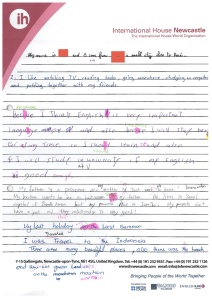I’ve said it before and I’ll say it again: I’m absolutely privileged to work at International House Bydgoszcz. Our staff are motivated, engaged, and creative, and always willing to share their ideas. Everyone really cares about teaching and doing the best for our students.
For the last couple of weeks, our Friday workshops have become brainstorming sessions. We start a Google Doc on a specific aspect of teaching online, then head into breakout rooms to share ideas and add to the document. They add their names, and when we return to the main room we ask for clarification or explanations of anything we don’t understand. So far we’ve covered warmers, feedback and error correction, and now movement.
In just 30 minutes on Friday 8th May, IH Bydgoszcz teachers past and present produced this fantastic list of ideas for adding movement to online lessons, and they agreed to let me share it on my blog. I’ve organised them into categories and removed school-specific terminology, but apart from that, they’re as written during the session. Thanks to everyone who added to this list! If you have other ideas, please share them in the comments.
Please note: if you share this post (thank you!), please credit ‘IH Bydgoszcz teachers’, rather than me!

At the computer
Flash card, touch body – two flashcards on PPT or in hands. T says – word. If it is one flashcard – SS touch nose. If it is other flashcard, SS touch head. = receptive stage (Flash and touch – Jodie??)
Debate – They show you how much they agree/ disagree with a statement physically i.e. how much they stand up. Then, you group them with people who have the same/ or very different points of view in BOR for activity. (Jodie)
Body parts vocab: students stand up, T says show your ankle, S .. (Lotte)
Using mime to revise body / sports vocab using mime and the others guess. (Ranmal)
Use standing up/sitting down for feedback e.g. stand up if you agree. (Ranmal)
Storytelling- Ss suggest actions for parts of the story/ characters particularly repeating words that they do while you tell the story (Helen)
Alphabet actions- do an action for each letter of the alphabet (Jude G)
Mime a TV programme scenario to revise TV vocab (Jude G)
Simon says (Jude F)
True/false game (with kids): Come up with a random movement for true/false, e.g. stand up and wiggle for true, pat your head if false. The teacher or a student says a sentence about a picture. Ss do the movement for T/F. (Char)
“Board” slap > notebook slap – Ss write/draw words in notebook and touch. Or on post its to stick on walls in the house (Shannon, via Sandy a few weeks ago)
One student goes outside/behind the computer for 30 seconds with their sound off – the rest of the students make a shape/start doing an action. That student comes back and has to guess what the word is. You can do it with the waiting room function too, but this is potentially more fun. (Sandy)
Play some music for everyone to dance to. When it stops, they need to make a shape that represents a recent piece of vocab. Everyone then calls out what they can see: James is an elephant, Sandy is a lion, etc. (Sandy)
Away from the computer
Scavenger hunt- items, vocab, fun (Lee and Ash)
Mute mic and run – T has list of vocab on the board. Class is in 2 teams. T says ‘which one is…. + def’. Then, says two SS names. The ss run (by which I mean walk sensibly) and start the microphone and say. Fastest = points. (Jodie)
Vocab: Find something you can describe as ‘______’ i.e. ancient. (They go find one of their many ancient artefacts at home). (Jodie).
Ask students to get something from different rooms in their house – practicing rooms in a house (Ranmal)
Let students get a book or another prop from their room or house. Give them a time limit (Lotte)
Birdwatching. I taught young learners the names of some birds & some bird vocab. Then they could go to their window/balcony, do a spot of birdwatching, and tell each other what they saw. (Gareth)
Show us your garden! Connections and gardens permitting (Helen)
Run and get something to introduce to the group related to grammar vocab for that lesson – this is my dog which I…, this is my sister who.. (Jude G)
Give Ss 3 mins to run and find something to explain a concept from the lesson. In my advanced adult group they had to find something to explain the concept of time (Katharine)
Go and find something to tell a story about and other Ss have to guess if it’s true or false (Katharine)
Find an object to describe using new vocabulary e.g. pretentious art adjectives (Katharine)
Go on Pet Safari to practise present continuous. Follow a pet around the house and narrate what they are doing. Can use a stuffed toy if they don’t have a pet (Ruth)
New vocabulary such as films or books – (adjectives for or categories) get ss to get up and find as many examples as they can in their house and show to each other on the camera. (Monica)
As mental breaks
Star jumps etc. as a little break for young learners. (Lotte)
Random brain breaks (for kids): (Char)
- rub your belly and pat your head
- try to lick your elbow
- pinch your nose with your right hand and touch your right ear with your left hand, then swap
- find something (green)
- be a (cat, chair, rock)
‘Yoga for kids’ – share video via YouTube and Ss do at home (Shannon)
Click your fingers: one hand click a triangle, one hand click a line (Lee)
Dance to a Super Simple Songs video (Sandy)
Get Ss to dance along to old 70s/80s aerobics videos (purely for teacher’s entertainment but also as an energy burner) (Connor)
Useful links
Here are two other posts about how to add movement to your online lessons:
https://sandymillin.wordpress.com/2020/04/10/adding-movement-to-online-lessons-guest-post/
https://jamesegerton.wordpress.com/2020/04/25/i-like-to-move-it-move-it-webinar-let-off-quaransteam/









 , page 53, Unit 6C
, page 53, Unit 6C


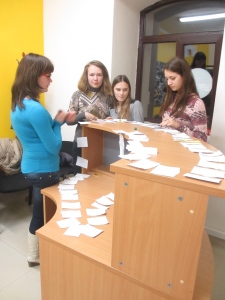



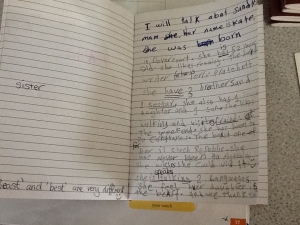
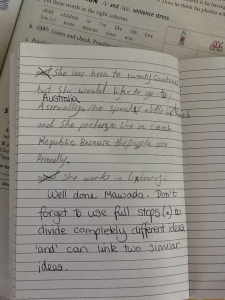

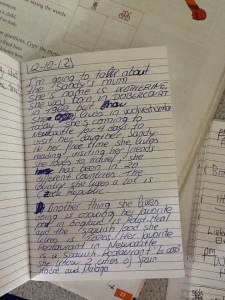








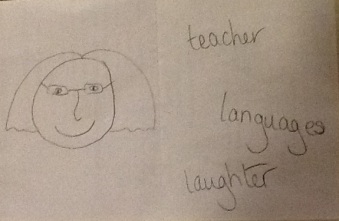




 For the last ten minutes, they divided a piece of paper into four and wrote sentences describing everything they knew about the four main characters. For example:
For the last ten minutes, they divided a piece of paper into four and wrote sentences describing everything they knew about the four main characters. For example:
